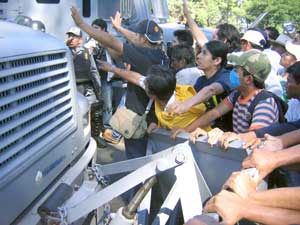OAXACA, MEXICO
Struggle grows to oust governor
People’s power resists massive police assault
By
Bob McCubbin
Published Nov 1, 2006 10:22 PM
Oct. 31—What is most
striking in the unfolding confrontation in the Mexican state of Oaxaca is the
tremendous courage being shown by the Oaxacan people in the face of brutal
repression ordered by the Mexican government.
For over five months now, 70,000
Oaxacan teachers have been on strike and the people of the state, in solidarity
with the teachers, have been demanding the resignation of corrupt Oaxacan Gov.
Ulises Ruiz.
Last May, in the face of
government rejection of their demands and threats by the governor to use
violence against them, the teachers found it necessary to escalate their tactics
with road blockades, the occupation of the central plaza in the city of Oaxaca,
and demonstrations, including huge marches of 80,000 and later 120,000,
mobilizations which included workers, students and Indigenous people.
The government’s response to the
strong support for the teachers by the people of Oaxaca was to use tear gas,
arrests and killings to try to force them back to work. In the middle of June,
with growing recognition that the government was not really interested in
negotiations, the teachers and supporting mass organizations formed the Popular
Assembly of the People of Oaxaca (APPO). This representative body has since
functioned more and more as an alternative to the corrupt, repressive state and
local governments. It has constantly grown in authority as the people’s
answer to Ruiz’s refusal to resign and to the federal government’s
refusal to disempower his discredited government.
In August the people’s movement
took control of several radio and television stations and 20 official government
vehicles. They also occupied the state government palace. At the same time,
paramilitary goons, now proven by video footage to be affiliated with Ruiz and
his rich cronies, increased their attacks against the people’s movement.
Repressive forces sent in by the federal government began their ominous
infiltrating and reconnoitering, including periodic overflights of the city of
Oaxaca by military planes and helicopters.
Before the government assault began on
Oct. 28, paramilitary forces directed by local leaders of Ruiz’s party,
the Partido Revolucionario Institucional (PRI), had killed at least 15 people.
New reports say at least three more people were
killed.
Mexican federal police and
soldiers, along with their armored vehicles and other equipment, began massing
outside the city of Oaxaca several weeks ago. Then, on Oct. 27, Ruiz’s
paramilitaries killed three people: a Oaxacan teacher named Emilio Alonso
Fabián, a protester named Esteban Zurita López, and an Independent
Media Center reporter from the U.S. named William Bradley Roland (Brad Will).
The government used this murderous assault as an excuse to begin its attack on
Oaxaca.
On Oct. 28, Mexican president
Vicente Fox ordered thousands of federal police, military police and soldiers,
including some disguised as police, into the capital city. Using water cannons,
tear gas and clubs against the city’s occupants and bulldozers to push
aside the many barricades that barred passage to the city’s center, the
repressive forces eventually managed to seize the central plaza. They have not,
however, been able to stop the protests demanding they leave Oaxaca and take
Ruiz with them.
On Monday morning, Oct.
30, Flavio Sosa, a leader of APPO, accused the government’s forces of
breaking into many buildings during their attack, torturing captured members of
APPO, killing at least three people and arresting at least 60 others. He added:
“This city is standing up. The Oaxacan people are resisting. Thousands of
supporters are approaching the city, and today there are strong mobilizations to
demand that the federal police leave Oaxaca.” (La Jornada
online)
The same day, La Jornada
columnist Gustavo Esteva told Pacifica radio’s Amy Goodman: “Yes,
the police is occupying these critical strategic points, but the people are
surrounding them. They are not in control of the city; the people are still in
control of the city.”
Goodman also
reported the words of an unidentified protester: “We’re just people,
the people fighting for our rights. We don’t want to live like this
anymore. We don’t want to live in a constant state of repression, of
blackmail, of murder and shabby deals.” (Democracy Now, Oct.
30)
Indeed, as this is written, protests
in many cities of the Mexican Republic and in many other countries are being
reported. In the U.S., supporters of the Oaxacan teachers have already gathered
at Mexican consulates in several cities to voice their condemnation of the
attack on Oaxaca and their outrage at the murder of Brad Will. Leaders of
teachers’ unions in at least six Mexican states and the Federal District
that encompasses Mexico City, in total representing 400,000 teachers, have
announced a strike to protest the government attack. (La Jornada, Oct. 30)
Articles copyright 1995-2012 Workers World.
Verbatim copying and distribution of this entire article is permitted in any medium without royalty provided this notice is preserved.
Workers World, 55 W. 17 St., NY, NY 10011
Email:
[email protected]
Subscribe
[email protected]
Support independent news
DONATE


